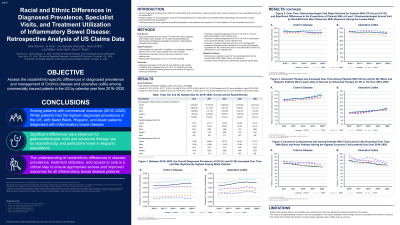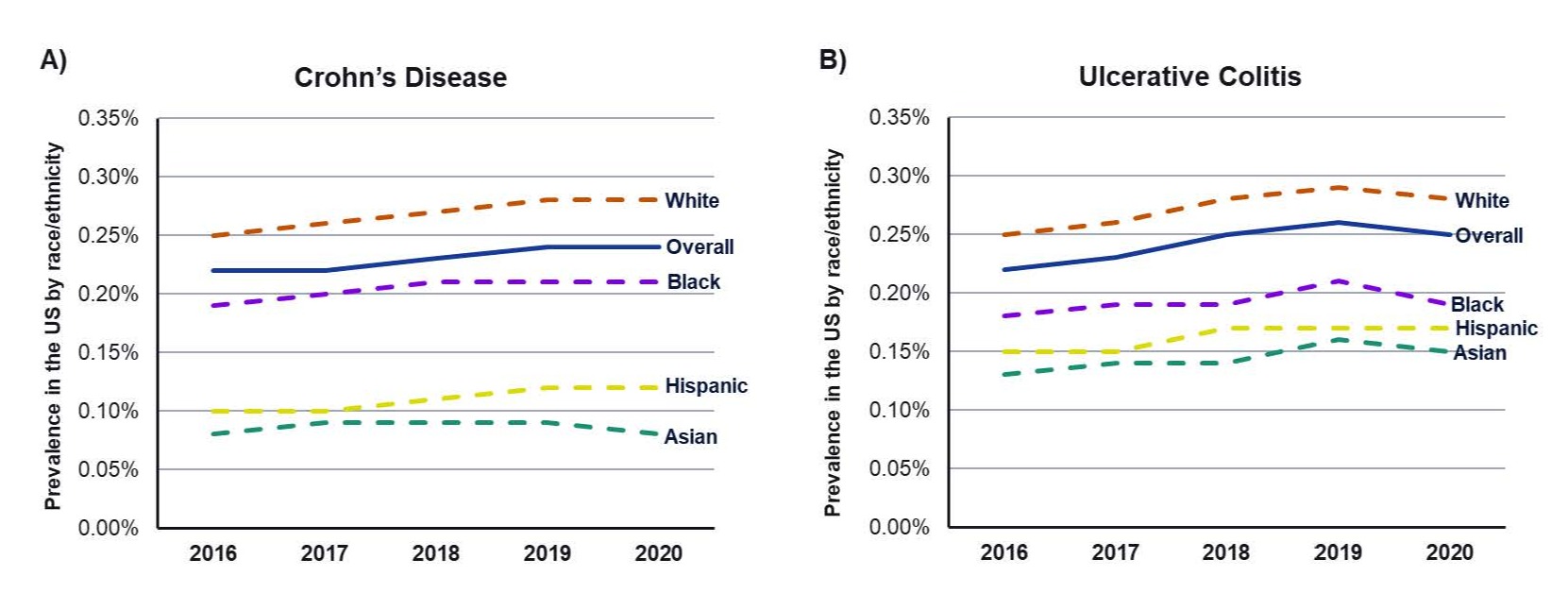Back


Poster Session E - Tuesday Afternoon
Category: IBD
E0411 - Racial and Ethnic Differences in Diagnosed Prevalence, Specialist Visits, and Treatment Utilization of Inflammatory Bowel Disease: Retrospective Analysis of U.S. Claims Data
Tuesday, October 25, 2022
3:00 PM – 5:00 PM ET
Location: Crown Ballroom

Has Audio
- LM
Lisa Malter, MD
NYU/Bellevue
New York, NY
Presenting Author(s)
Dolly Sharma, PhD1, Si Xuan, PhD1, Yuri Sanchez-Gonzalez, PhD1, Jenny Griffith, 1, Lisa Malter, MD2, Anita Afzali, 3, David T. Rubin, MD, FACG4
1AbbVie, Inc., North Chicago, IL; 2NYU/Bellevue, New York, NY; 3University of Cincinnati, Cincinnati, OH; 4University of Chicago Medicine Inflammatory Bowel Disease Center, Chicago, IL
Introduction: Conflicting evidence exists regarding racial/ethnic disparities in the treatment and outcomes of Crohn’s disease (CD) and ulcerative colitis (UC). This study assessed the racial/ethnic-specific differences in diagnosed prevalence and management of CD and UC among commercially insured patients (pts) in the US.
Case Description/Methods: Adults with CD or UC were identified from the Optum™ Clinical and Claims Database (2016–2020; 15–18 million annual beneficiaries). Diagnosed prevalence of CD and UC, proportion of pts with ≥1 gastroenterologist (GE) visit, excessive corticosteroid use (defined as ≥10 mg/day of prednisone equivalents for ≥60 consecutive days or one prescription of ≥600 mg prednisone per year), and use of any advanced therapy (AT) were assessed by race/ethnicity (White, Black, Asian, and Hispanic) and reported by year. Comparisons were made by Chi square tests.
Between 2016–2020, overall diagnosed prevalence of CD and UC increased and was highest among White pts; Hispanic and Asian pts had the lowest diagnosed prevalence (Figure). Over time, GE visit rates declined for CD (Δ3%) and UC (Δ4%) pts and there were significant differences in the proportion of pts with an annual GE visit by race/ethnicity in 2020 among the CD (Asian: 75.5%; White: 69.8%; Black: 68.5%; Hispanic: 62.6%) and UC populations (Asian: 71.0%; White: 67.8%; Black: 69.1%; Hispanic: 61.5%). AT use increased over time (CD: Δ6%; UC: Δ5%) with almost twice as many CD pts (39.7%) receiving an AT compared to UC pts (21.1%). In 2020, significant differences were found for AT use by race race/ethnicity. Generally, fewer Hispanic (36.2% CD, 19.8% UC) and Black pts (37.4% CD, 19.1% UC) with CD or UC were prescribed AT vs White (40.2% CD, 21.5% UC) and Asian (42.4% CD, 22.3% UC) pts. Excessive corticosteroid use among pts with CD (12.1%) and UC (13.2%) decreased over time (Δ2%), with no significant differences by race/ethnicity.
Discussion: Among pts with commercial insurance (2016–2020), White pts had the highest diagnosed prevalence in the US, with fewer Black, Hispanic, and Asian pts diagnosed with IBD. Significant differences were observed for GE visits and AT use by race/ethnicity, especially in Hispanic populations. These findings may vary in populations with other/no insurance. The understanding of racial/ethnic differences in disease prevalence, treatment utilization, and access to care is a critical first step to ensuring appropriate access and improved outcomes for all pts.

Disclosures:
Dolly Sharma, PhD1, Si Xuan, PhD1, Yuri Sanchez-Gonzalez, PhD1, Jenny Griffith, 1, Lisa Malter, MD2, Anita Afzali, 3, David T. Rubin, MD, FACG4. E0411 - Racial and Ethnic Differences in Diagnosed Prevalence, Specialist Visits, and Treatment Utilization of Inflammatory Bowel Disease: Retrospective Analysis of U.S. Claims Data, ACG 2022 Annual Scientific Meeting Abstracts. Charlotte, NC: American College of Gastroenterology.
1AbbVie, Inc., North Chicago, IL; 2NYU/Bellevue, New York, NY; 3University of Cincinnati, Cincinnati, OH; 4University of Chicago Medicine Inflammatory Bowel Disease Center, Chicago, IL
Introduction: Conflicting evidence exists regarding racial/ethnic disparities in the treatment and outcomes of Crohn’s disease (CD) and ulcerative colitis (UC). This study assessed the racial/ethnic-specific differences in diagnosed prevalence and management of CD and UC among commercially insured patients (pts) in the US.
Case Description/Methods: Adults with CD or UC were identified from the Optum™ Clinical and Claims Database (2016–2020; 15–18 million annual beneficiaries). Diagnosed prevalence of CD and UC, proportion of pts with ≥1 gastroenterologist (GE) visit, excessive corticosteroid use (defined as ≥10 mg/day of prednisone equivalents for ≥60 consecutive days or one prescription of ≥600 mg prednisone per year), and use of any advanced therapy (AT) were assessed by race/ethnicity (White, Black, Asian, and Hispanic) and reported by year. Comparisons were made by Chi square tests.
Between 2016–2020, overall diagnosed prevalence of CD and UC increased and was highest among White pts; Hispanic and Asian pts had the lowest diagnosed prevalence (Figure). Over time, GE visit rates declined for CD (Δ3%) and UC (Δ4%) pts and there were significant differences in the proportion of pts with an annual GE visit by race/ethnicity in 2020 among the CD (Asian: 75.5%; White: 69.8%; Black: 68.5%; Hispanic: 62.6%) and UC populations (Asian: 71.0%; White: 67.8%; Black: 69.1%; Hispanic: 61.5%). AT use increased over time (CD: Δ6%; UC: Δ5%) with almost twice as many CD pts (39.7%) receiving an AT compared to UC pts (21.1%). In 2020, significant differences were found for AT use by race race/ethnicity. Generally, fewer Hispanic (36.2% CD, 19.8% UC) and Black pts (37.4% CD, 19.1% UC) with CD or UC were prescribed AT vs White (40.2% CD, 21.5% UC) and Asian (42.4% CD, 22.3% UC) pts. Excessive corticosteroid use among pts with CD (12.1%) and UC (13.2%) decreased over time (Δ2%), with no significant differences by race/ethnicity.
Discussion: Among pts with commercial insurance (2016–2020), White pts had the highest diagnosed prevalence in the US, with fewer Black, Hispanic, and Asian pts diagnosed with IBD. Significant differences were observed for GE visits and AT use by race/ethnicity, especially in Hispanic populations. These findings may vary in populations with other/no insurance. The understanding of racial/ethnic differences in disease prevalence, treatment utilization, and access to care is a critical first step to ensuring appropriate access and improved outcomes for all pts.

Figure: Figure 1: Prevalence of Crohn’s Disease and Ulcerative Colitis by Race/Ethnicity in the US from 2016—2020
White, Black, and Asian patients are non-Hispanic.
White, Black, and Asian patients are non-Hispanic.
Disclosures:
Dolly Sharma: AbbVie – Employee, Stock-publicly held company(excluding mutual/index funds).
Si Xuan: AbbVie – Employee, Stock Options.
Yuri Sanchez-Gonzalez: AbbVie – Employee, Stock Options.
Jenny Griffith: Abbvie – Employee, Stock-publicly held company(excluding mutual/index funds).
Lisa Malter: Abbvie – Advisory Committee/Board Member. Abbvie – Grant/Research Support. Gilead – Advisory Committee/Board Member. Janssen – Advisory Committee/Board Member. Janssen – Grant/Research Support. Merck – Advisory Committee/Board Member. Pfizer – Grant/Research Support. Takeda – Advisory Committee/Board Member. Takeda – Grant/Research Support. UCB – Grant/Research Support.
Anita Afzali: AbbVie – Consultant, Speakers Bureau. Bristol Myers Squibb – Consultant, Speakers Bureau. DiaSorin – Consultant. Eli Lilly – Consultant. Gilead – Consultant. Janssen – Consultant, Speakers Bureau. Pfizer – Consultant, Speakers Bureau. Takeda – Consultant, Speakers Bureau. TLL Pharmaceuticals – Consultant.
David Rubin: AbbVie – Consultant. Alimentiv Inc. – Consultant. AltruBio – Consultant. Arena Pharmaceuticals – Consultant. Aslan Pharmaceuticals – Consultant. Athos Therapeutics – Consultant. Bellatrix Pharmaceuticals – Consultant. Boehringer Ingelheim, Ltd. – Consultant. Bristol Myers Squibb – Consultant. Celgene Corp/Syneos – Consultant. ClostraBio – Consultant. Connect BioPharma – Consultant. EcoR1 – Consultant. Genentech/Roche – Consultant. Gilead Sciences – Consultant. Ironwood Pharmaceuticals – Consultant. Iterative Scopes – Consultant. Janssen – Consultant. Kaleido Biosciences – Consultant. Lilly, Eli & Co – Consultant. Materia Prima – Consultant. Pfizer – Consultant. Prometheus Biosciences – Consultant. Reistone Biopharma – Consultant. Seres Therapeutics, Inc – Consultant. Takeda – Consultant, Grant/Research Support. Target RWE – Consultant. Techlab – Consultant. Trellus Health – Consultant.
Dolly Sharma, PhD1, Si Xuan, PhD1, Yuri Sanchez-Gonzalez, PhD1, Jenny Griffith, 1, Lisa Malter, MD2, Anita Afzali, 3, David T. Rubin, MD, FACG4. E0411 - Racial and Ethnic Differences in Diagnosed Prevalence, Specialist Visits, and Treatment Utilization of Inflammatory Bowel Disease: Retrospective Analysis of U.S. Claims Data, ACG 2022 Annual Scientific Meeting Abstracts. Charlotte, NC: American College of Gastroenterology.

